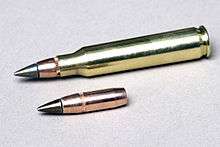Green bullet


Green bullet, green ammunition or green ammo are nicknames for a United States Department of Defense program to eliminate the use of hazardous materials from small arms ammunition and from small arms ammunition manufacturing. Initial objectives were elimination of ozone-depleting substances, volatile organic compounds, and heavy metals from primers and projectiles. These materials were perceived as causing difficulties through the entire life cycle of ammunition. The materials generated hazardous wastes and emissions at manufacturing facilities and use of ammunition caused contamination at shooting ranges. Potential health hazards made demilitarization and disposal of unused ammunition difficult and expensive.[1]
The Joint Working Group for Non-Toxic Ammunition was formed by the Small Caliber Ammunition Branch of the United States Army Armament Research, Development and Engineering Center in October 1995. Members of the working group included the National Guard of the United States, the United States Coast Guard, the United States Army Infantry School, the Industrial Operations Command, the Lake City Army Ammunition Plant, the Oak Ridge National Laboratory, the Los Alamos National Laboratory and the United States Department of Energy Kansas City Plant.[1]
Legislation
October 11, 2013 Governor Jerry Brown of California signed into law AB 711 Hunting: nonlead ammunition.[2] Cost reductions from conversion to green ammo are estimated at "$2.5 million required for waste removal at each outdoor firing range as well as the $100 thousand annual costs for lead contamination monitoring".[3]
Identified hazardous materials
| Hazardous material | Location[1] | New material |
|---|---|---|
| antimony | projectile | tungsten-tin or -nylon[4] |
| antimony trisulfide | primer | diazodinitrophenol (DDNP)[5] |
| barium nitrate | tracer or incendiary projectile | |
| barium peroxide | primer and tracer or incendiary projectile | diazodinitrophenol |
| ethyl acetate | blank cartridge tip sealant | Solventless process[6] |
| ethyl alcohol | tracer or incendiary projectile | |
| glycol ether | painted projectile point | |
| lead | projectile | tungsten-tin or -nylon[7] |
| lead dioxide | tracer or incendiary projectile | |
| lead styphnate | primer | diazodinitrophenol, MIC, e.g. Al/MoO3 |
| methyl chloroform | casemouth sealant and tracer or incendiary projectile | |
| methyl ethyl ketone | primer and sealants for primer pocket and blank cartridge tip | Solventless process |
| methyl isopropyl ketone | primer and sealants for primer pocket and blank cartridge tip | Solventless process |
| toluene | primer and sealants for primer pocket and blank cartridge tip | Solventless process |
| xylene | sealants for primer pocket and blank cartridge tip |
Green ammunition
Two green ammunition cartridges are the 5.56×45mm NATO M855A1 and the MK281 40 mm grenade. Switching to the 5.56 mm green bullet, the M855A1 Enhanced Performance Round, or EPR, in 2010 has eliminated nearly 2,000 tons of lead from the waste stream.[8] U.S. Army representatives at a 2013 House Armed Services Committee hearing have credited the 5.56mm M855A1 Enhanced Performance Round “close to” those of a 7.62mm in its performance capabilities.[9]
References
- 1 2 3 Bunting, Wade H. (September–October 1997). "Hazardous Technical Information Services Bulletin". 7 (5): 4–5.
- ↑ "California signed into law AB 711 Hunting: nonlead ammunition". October 11, 2013.
- ↑ John Middleton (2000). "Elimination of Toxic and VOC Constituents from Small Caliber Ammunition (WP-1057)".
- ↑ Don Mikko (June 2000). "U.S. Military Green Bullet. A Technical Report".
- ↑ Michael Courtney and Amy Courtney (2012). "High-speed measurement of firearm primer blast waves". arXiv:1203.2701
 .
. - ↑ T. G. Manning; D. Thompson; M. Ellis; R. Lieb; M. Leadore; J. Colburn; B. E. Homan; D. A. Worrell; K. B. Moran; S. J. Ritchie. "Environmentally Friendly 'Green' Propellant for the Medium Caliber Training Rounds".
- ↑ , Jack Erickson, Joel Sandstrom, Gene Johnston, Neal Norris, Patrick Braun, Reed Blau, Lisa Spendlove Liu, "Non-toxic percussion primers and methods of preparing the same"
- ↑ Audra Calloway (1 July 2013). "Picatinny ammo goes from regular to unleaded". Army.mil. Retrieved 30 December 2014.
- ↑ Scott R. Gourley (May 7, 2013). "U.S. Army Touts M855A1 Round Performance 'Close to' a 7.62". Defense Media Network. Retrieved 30 December 2014.